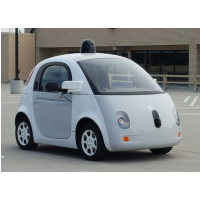Google Unhappy with DMV for Requiring a Driver in Driverless-Car Regs

Google officials say they can have a functional driverless car on the road in five years, but they might have to do their testing outside of California after state officials unveiled long-awaited draft regulations for the vehicles Wednesday.
Google wants to develop a robot car that doesn’t need controls tacked on for a human, but the Department of Motor Vehicles (DMV) said the product released to the public should be equipped with all of them. That would include a steering wheel, brakes and an accelerator for openers.
“We just aren’t ready to take that driver out yet,” DMV spokeswoman Jessica Gonzalez told the San Francisco Chronicle.
Google officials were not happy. “We’re gravely disappointed that California is already writing a ceiling on the potential for fully self-driving cars to help all of us who live here,” the company said in a press release.
California testing regulations took effect in September 2014 and 11 companies have permits to put driverless cars on public roads, as long as there is a licensed driver along for the ride. Google didn’t like the empowered-driver testing requirement either.
Google, which is testing driverless cars in Mountain View and Austin, Texas, is said to be considering a shift outside of California. Only a handful of states, including Nevada, have passed regulations to allow the testing of driverless cars on public roads.
The new rules require that a licensed driver be in the vehicle and equipped to take over control of the car if desired. But some of the other rules are also significant. Manufacturers cannot sell the cars, only lease them. Liability in accidents rests with the car’s operator, even when they aren’t in control of the vehicle.
Manufacturers would initially only be able to deploy their vehicles using a three-year lease permit. They must submit monthly reports on performance and safety to the state. The regulations direct that consumers be told what data is gathered on them and the car “that is not necessary for the safe operation of the vehicle,” and require their written permission.
The cars would have to be equipped to detect a cyber attack on their computer brains and alert the human so they can override the system.
The regulations could also affect companies like Tesla and Mercedes-Benz that are developing features, like auto-park, based on driverless technology.
The DMV will conduct public workshops on the regulations in Sacramento on January 28 and Los Angeles on February 2
–Ken Broder
To Learn More:
DMV Wants Driverless Cars to Have Licensed Drivers (by Michael Cabanatuan, San Francisco Chronicle)
Google “Disappointed” by Proposed Restrictions on Driverless Cars (by Jessica Guynn and Marco della Cava, USA Today)
Google Is “Disappointed” With California’s New Self-Driving Cars Rules (by Kirsten Korosec, Fortune)
Eye On Safety, California Sets Tight Rules for Self-Driving Cars; Driver Must Be Behind Wheel (by Justin Pritchard, Associated Press)
DMV Puts Google Car Drivers Back Behind the Steering Wheel (by Ken Broder, AllGov California)
- Top Stories
- Controversies
- Where is the Money Going?
- California and the Nation
- Appointments and Resignations
- Unusual News
- Latest News
- California Forbids U.S. Immigration Agents from Pretending to be Police
- California Lawmakers Urged to Strip “Self-Dealing” Tax Board of Its Duties
- Big Oil’s Grip on California
- Santa Cruz Police See Homeland Security Betrayal in Use of Gang Roundup as Cover for Immigration Raid
- Oil Companies Face Deadline to Stop Polluting California Groundwater





